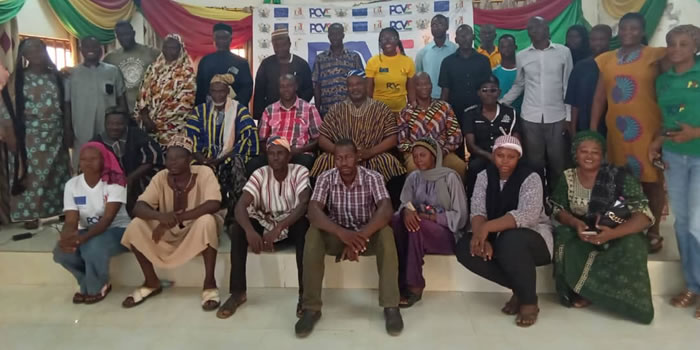

School attendance
Education plays a vital role in the development of a nation through human capital formation. School enrollment and attendance ensures that the citizenry attain the needed level of education for economic development. Figure 3.2 presents school attendance in the district by sex. The figure shows that 63.8 percent of persons aged 3 years and older in the district have never attended school. More females (69.6%) than males (58.0%) have never attended school. Currently, 29.6 percent of persons 3 years and older in the district are attending school.
Table 3.10 shows the population three years and older by level of education, school attendance and sex. The population three years and older who are currently attending school is 10,491. More than fifty percent (54.4 %) are in Primary, 17.2 percent in Nursery, 14 percent in JSS/JHS, 1.7 percent in Tertiary and 0.3 percent in Vocational/Technical/Commercial institutions. About 55.0 percent of females currently in school are attending primary school.
The percentage of males who are currently in school and are in primary school represent 53.7 percent of males who are three years and older. The Table also shows that the total number of person three years and older who attended school in the past is 2,335. About 58.4 percent of them attended primary school, 17.2 percent attended JHS/JSS, 12.8 percent SSS/SHS and 4.5 percent middle school. In absolute terms and with the exception of primary, there were more males than females in all the other levels of education. Thirty-three males attained tertiary education in the past compared to only 11 for females.
Literacy and Education
Education is an important aspect of societal development. It is the process of acquiring knowledge, skills, values and attitudes to fully develop individual capacities for societal wellbeing. There is a relationship between education, human resource development and economic growth (United Nations Development Programme, 2011). Countries therefore place emphasis on educational policies in designing their plans to accelerate development. It is for this reason that of the eight Millennium Development Goals (MDGs) one of the goals (MDG 2) is achieving universal primary education by 2015 (United Nations Development Programme, 2010).
Literacy In the 2010 Population and Housing Census, literacy was defined as the ability to read and write a simple statement with understanding. If a person can only read but cannot write or can write but cannot read, he or she is not literate. Similarly, if a person was literate some time ago but cannot read and write with understanding at present then he/she is not literate. Table 3.9 presents population 11 years and older by sex, age and literacy status.
The Table depicts that 75.8 percent of the population 11 years and older are literate in English and Ghanaian language. Persons literate in English only constitute 15.1 percent and those literate in Ghanaian language only represents 8.7 percent. Less than one percent are literate in English and French.
Date Created : 11/21/2017 6:06:10 AM










 facebook
facebook
 twitter
twitter
 Youtube
Youtube
 +233 593 831 280
+233 593 831 280 0800 430 430
0800 430 430 GPS: GE-231-4383
GPS: GE-231-4383 info@ghanadistricts.com
info@ghanadistricts.com Box GP1044, Accra, Ghana
Box GP1044, Accra, Ghana